Posted by R. John Howe on 11-08-2002 08:17 AM:
Scandinavian Textile?
Dear folks -
Early this year while traveling in northern Ohio, I
bought the flatwoven textile below at a large antique coop in a booth that
offered mostly North American Indian items.
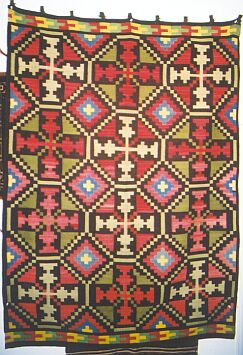
Here is a somewhat closer look at part of it.
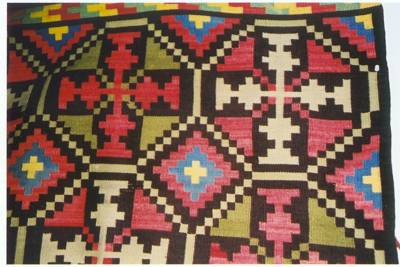
This piece is 47 inches wide and 67 inches long. It is
entirely in wool and seems to have been woven in a species of weft-faced
"dovetailed" or "comb-toothed" tapestry (there are no "slits.") The "handle" is
“hardish,” has “substance,” and is much stiffer than that
of a Navajo piece. The side “selveges” (which may in fact just be
continuations of the weaving of the field but in a different color) are about
six or seven “cords” wide and are in dark brown. The ends, top and
bottom, are rolled over and sewn down. There are loops at the top indicating
that it was used as a wall hanging but these seem to have been added sometime
after the piece was woven.
The colors are an olive green, a rich, dark
brown, a medium red that is abrashed in some areas, a lighter, brighter green,
a mild yellow, an ivory, and a blue-green that is not quite a tourquoise (this
latter color looks like a more straightforward blue, in the images on my
monitor, than it is). I think the dyes are mostly synthetic, but the person who
selected these colors and determined their use in the design was very familiar
with the natural dye palette and the color harmony of this piece is very good
indeed.
The design has a lot of graphic impact and features major
ornaments similar to Turkmen guls that have a distinctive cruciform device at
its center. (This device has prompted some to say that it’s Scandinavian.)
The minor field ornament is a polychrome stepped diamond with a simple cross at
its center. There is a single band of "tuning fork" devices horizontally at
both the top and the bottom of the piece.
It is in excellent condition
and shows no apparent wear of its materials. There is some sign that the red
dye has faded (light exposure?) in some areas. I cannot estimate its age.
I would be interested in thoughts others might have about what this
piece might be, and especially where it might have been
woven.
Regards,
R. John Howe
Posted by Wendel Swan on
11-08-2002 09:50 AM:
Hi John,
You have a Swedish rolakan, a type of tapestry that is
found in various formats and designs: cushions, covers, Swedish khordjin that
imitate their Persian prototypes and others that clearly copy rugs of the
Holbein type.
Some rolakan bear dates in the 18th Century, but they are
still made. It is difficult to judge their age by comparing colors to products
from the Middle East. Even the older ones don't have the depth and saturation
of color that we expect in our oriental rugs and textiles.
The cruciform
shapes are really octagonal variants. You shouldn't read them as having any
religious or geographic significance.
I'd like to see
it.
Wendel
Posted by R. John Howe on 11-08-2002 06:04
PM:
Wonderful Information Instantly!
Dear folks –
Every once in awhile we get a demonstration of
the true advantages of this medium in which we converse and here is
one.
The information flow about this little piece of mine has been
nearly instantaneous and absolutely wonderful.
First, Wendel Swan wrote
indicating that I have a Swedish textile called a “rolakan.” He knew
quite a bit about this format.
Armed with that term, I went to Peter
Stone’s “The Oriental Rug Lexicon,” whose entry
says:
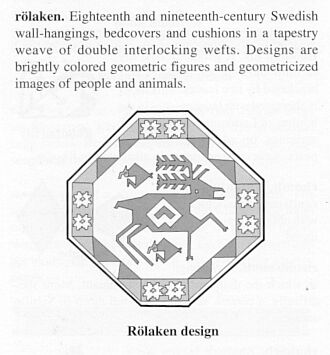
Then Filiberto Boncompagni sent me an email on
the side alerting me to an article on page 86 of volume 86, of
“Hali,” by Michael Franses, entitled “Wedding Textiles from
Scania.” It seems likely to be a nearly definitive piece on
“rolakans.” (Who knows more than Michael Franses in the rug world?
 )
)
Here is Franses’ first facing image.
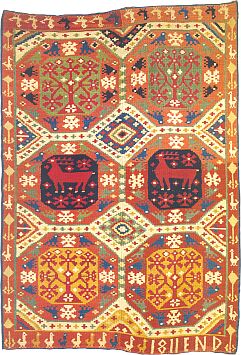
Franses’ article continues through page 91 and I will
“mine” it a bit in other posts in this thread just in case you
don’t have ready access to volume 86.
Thanks, guys. Made my
afternoon.
Look, Daniel!! “Chickens” in the
border!!!
Regards,
R. John Howe
Posted by R. John
Howe on 11-09-2002 04:42 PM:
Structure of the Piece
Dear folks –
One of the things that impressed me about
Wendel’s response above (after I had initially read the Franses
“Hali” article) was its precision.
Franses says that several
structures were used to make these Swedish wedding textiles. Some are made in a
“double-interlocked” tapestry, some in “dovetailed
tapestry,” some in pile, some with extra-weft patterning, and some are
embroidered. Franses indicates that the term “rolakan” refers to the
“double-interlocked” structure and that those made with
“dovetailed tapestry” are called “flamskvav,” this latter
term also referring to this latter structure. I knew from Marla Mallett’s
book that there is also a seemingly similar structure,
“single-interlocked” tapestry, that Franses doesn’t mention.
Marla simply refers to it as "interlocked" tapestry. The word "single" is one
used by others that I have adopted here.
Franses then
says:
“…The ‘rolakan’ technique was used to create
strongly geometric designs: the colours of these textiles are typically bright
and vibrant and their patterns naïve, almost child-like.
‘Flamskvav’ textiles were generally woven on a black or dark brown
ground, and usually small pictorial vignettes surrounded by naturalistic and
semi-naturalistic flowers drawn in freehand manner.” He goes on to
describe ‘flamscav’ designs as “curvilinear” and
“realistic” as opposed to the “highly abstracted” designs
of “other types of Swedish textiles.”
Here is Franses’
example of a cushion cover made in the “flamskvav”
technique.
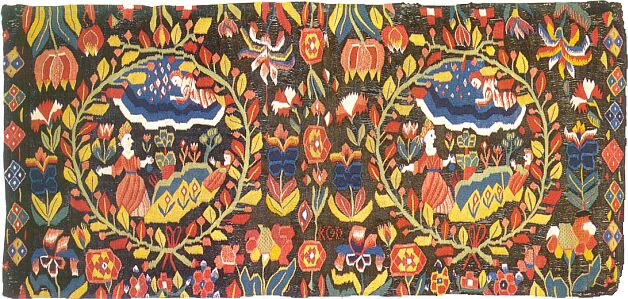
Well, my piece seems to fit the
“rolakan” description and image better than the ones for
“flamskvav,” so part of what was impressive about Wendel’s
response was that he not only knew that this was a piece to be placed among
these Swedish dowry textiles, he apparently also knew its structure
accurately.
Still, we have now been trained to recognize that it is
always useful to examine the piece itself. In preparation for doing so, I again
consulted Marla’s book “Woven Structures” for the distinctions
between “double interlocked” tapestry, “single interlocked”
tapestry and “dovetailed” tapestry.
Here to refresh your own
memories are the three drawings she provides:
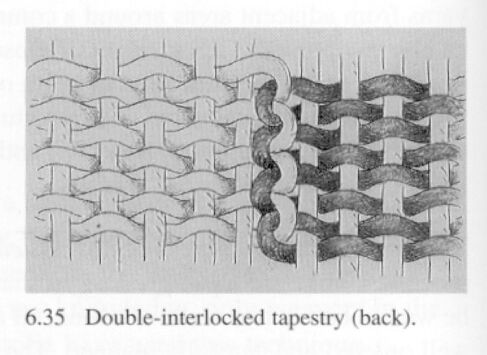
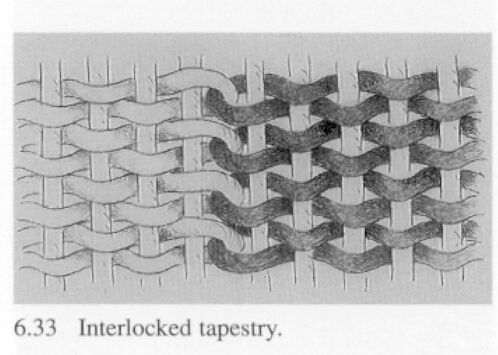
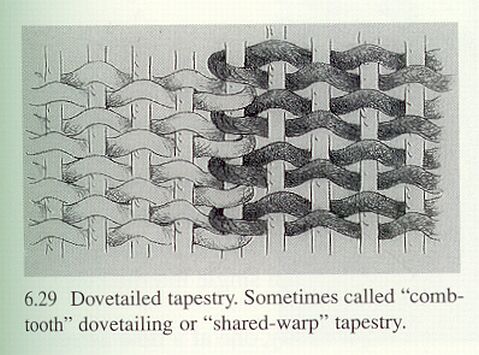
So which of these structures does my piece have? Here is a
close-up of a small area of vertical color change, the place where the
distinctions involved here would occur.

Visually, this structure looks to me from this image to be
“single-interlocked” tapestry, since I think I can see the wefts
looping through one another, but cannot see wefts moving inside two loops as
“double-interlocked” tapestry requires. But the handle of this piece
makes it seem closer to that of “double-interlocked” tapestry,
because I can feel (and in fact clearly see on its back) the
“thickness” that Marla seems to say is a characteristic of this
latter weave on the lines of the vertical color change. The edge at the
vertical color changes is ragged, but I cannot seen the two lines of opposing
color that ought to occur on both sides of a vertical color change in
“double-interlocked” tapestry (consult the
“double-interlocked” tapestry drawing again if it is not clear why I
think these two “lines” should be visible). Despite some hesitations,
I think this piece is woven using “double-interlocked”
tapestry.
Franses warns that the various weaves used in these wedding
textiles were often used “side-by-side,” so it would not be unlikely
find more than one of them in a single piece.
I would welcome other
thoughts and opinions, disadvantaged by distance as you are, about what, Wendel
has called, apparently with great precision, a
“rolakan.”
Regards,
R. John Howe
Posted by
R. John Howe on 11-10-2002 08:50 AM:
Michael Bischof Comment
Dear folks -
Wendel's suggestion that rolakan designs are often
taken from oriental rugs and textiles and that the medallion in my piece above
has echoes of "Holbein" usages has made us wonder whether Michael Bischof might
have some thoughts about this piece, especially since he lives in Germany but
visits Turkey often.
This morning he sent some by email. Here they
are:
"...By the way: your Scandinavion textile, R. John Howe. Because of
the many trouble I had with software from Bill Gates I actually have no access
to it: there is an interesting book showing at as ealry as in the 11th and 12th
centurey in Finland early textiles where made with designs that we would call
"typical Anatolian early medieval" or "17th/18th century Central Anatolian
village rugs". Apparently they were imported by the Vikings from some place far
south at some time before that, what fits well to what we know about their
movements .... I never had time to
research it further. When I read it I
found it interesting for Dr. Hofmachers and mine "theory" that the later
workshop designs evolved on this basis - and not the opposite way. Your piece
in particular is a typical "geometrical" early medieval example for its design
- how old it may be in reality I have no idea. Astonishing how conservative and
tradition-keeping these Scandinavian place have been."
Thanks, Michael.
I had been pushed by the seeming conventionalization of the design to see it as
a fairly recent piece (and it may well still be that) but it is interesting to
see that what seems like a simplification or conventionalization of design is
actually that of a quite early period.
Regards,
R. John Howe
Posted by Michael Bischof on 11-10-2002 09:15 AM:
Hallo everybody, hallo John Howe,
well, on a impression basis of
"judgement" ( how old is it according to my feelings ) I would join saying it
does not seem to be extreme old. A certain "flatness" of the dyes ( at least on
the digi) adds to that impression, especially when compared to the citation of
Franses. On the other hand: these big "fork" like motives in the horizontal
separation stripes you find in many early kilims and in stone-work for example
in the famous mosque in Divrigi - and this whole area was one huge yayla ground
for Turcomans in the early (!) middle ages.
Whatever, thank you a lot
for showing it !
Greetings,
Michael
Posted by
Deschuyteneer daniel on 11-13-2002 02:57 PM:
Hi John,
Without seeing the back it is difficult to know
what’s the sructure.
Here are two pictures (posted to Steve) which
can help from a Bakhtiary Khorjin woven with the typical “double
interlocked” tapestry technique. Viewed from the back it’s very easy
to be sure what’s the technique.
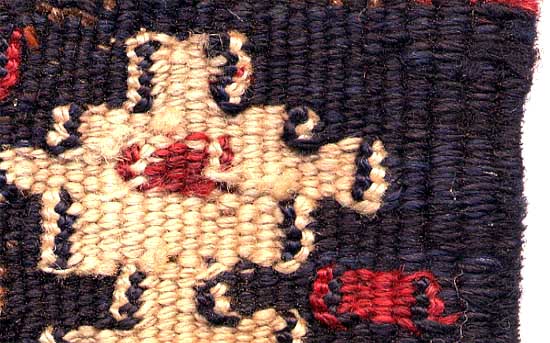
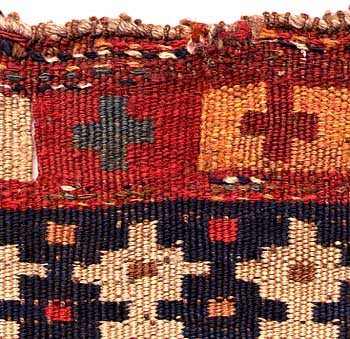
The pictures of the khorjin as well as
Marla’s comments are at the bottom of this page:
http://www.marlamallett.com/ef-h-cor.htm
Good photo
of single interlocked and double interlocked wefts in “twill
tapestry” weavings are available on this other page:
http://www.marlamallett.com/up-six.htm
Best,
Daniel
Posted by R. John Howe on 11-13-2002 10:03 PM:
Daniel -
Thanks for the images and the links.
Yes, you
show the reversal of color, I can see from Marla's drawing, should be in my
piece too, if it's really double-interlocked tapestry. But I'm still not seeing
it.
Here's another look and I made sure this time I was scanning the
back.
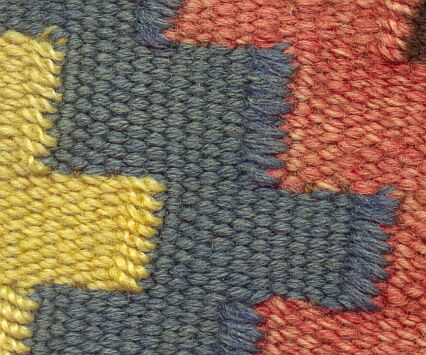
I still don't see the color reversals here
that are clearly visible on your Baktiari example. The size of the "stitches"
to the left of the vertical color changes are wider, but that's all.
I'm
still not entirely sure what the weave in my piece really is. I can see and
feel the "ridging" clearly.
What do others
see?
Regards,
R. John Howe
Posted by Patrick Weiler
on 11-14-2002 12:30 AM:
Dove Tailed
John,
Your weaving appears to be dovetailed tapestry weave. Both
colors share a single warp thread.
The interlocking varieties "interlock"
with each other. The dovetailed variety, also known as "shared warp" just has
both colors attaching to the same warp, thereby eliminating the vulnerable
"slit".
I do not find many of these weavings on the "oriental rug" market,
but they may be more common in other markets. Yours is a very lovely
version.
Patrick Weiler

Posted by Richard
Farber on 11-14-2002 12:34 AM:
Dear R. John Howe,
The colors seem on the computer to be of a
very different --- looking for the term --- aesthetic ... than the different
pallets one sees in various North African to East Asian textiles of different
periods. If you had a comfortable room say 25 to 30 square meters and could
furnish it as you wish, which other textiles would you hang in the same space
as this textile and what would you put on the floor?
Best
regards
Richard Farber
Posted by R. John Howe on 11-14-2002
08:17 AM:
Pat -
Your estimate is what I thought originally but it doesn't
explain the definite ridges that I think are not characteristic of the
dovetailed variety. Maybe Marla will rescue us, eventually.
Richard
-
I don't have the spatial luxury you describe, and I live with someone
who collects in a distinctive area, so competition for space is keen.
I
think part of the distinctive "palette" as you politely describe it, may result
in part from the fact that at least some of the dyes of this piece (the red in
particular) seem to me likely to be synthetic. And it may not have much age at
all. Wendel indicated that these pieces are still being made.
But I do
have a kind of answer to your "what does such a textile 'go with'?"
question.
At the moment the upper part of the wall behind my computer is
taken up with a number of bag faces, mostly Turkmen. Against the lower part of
this wall there is an antique drawing board with its table surface nearly
upright rather than flat. Over this board I have hung several pieces
overlapping one another (initially, I was considering what I wanted to take to
the TM on a particular Sat morning, but this use has persisted).
The
Swedish "rolakan" is one of these pieces but also on this board is a Turkish
yastik; a Siirt piece, very hairy, with a "faux knot;" a Navajo piece; a
Kurdish or Afshar "sofre," from Khurassan; and the striped back of a set of
Persian khorjin of unknown attribution. On the floor are two contemporary
Ersari Turkmen rugs, one of which is a Yomud jewelry asmalyk design. The small
wall to my left has two "tent pole covers" on one side of a window and on the
other side an array of small items, including an old Central Asia ikat
fragment, a small hooked rug, a front tab from a Kurdish horse covers, a
knitted doll's sweater, a small contemporary Navajo mat and an off-white
knitted doll's blanket.
So one answer to your question is that the
rolakan seems compatible with this very eclectic array of items. It does not
jar but rather adds it distinctiveness in a harmonious way.
I'm sure one
could envision a room, such as you describe, with quite spare furnishings such
as more modern Scandinavian ones often are or even a room furnished with
American Amish or Shaker pieces. If there was a second blank wall, a nice, dark
American quilt from Pennsylvania, Ohio or Indiana would be compatible. The rug
on the floor might be braided wool or, better, one of those commissioned by
Stickley early in the 20th century to go with his "Mission Oak" furniture. I
think the rolakan would feel quite at home in such a setting.
But
it doesn't seem unhappy "cheek and jowl" with the variety of textiles described
above.
Regards,
R. John Howe
Posted by Vincent Keers
on 11-14-2002 06:22 PM:
Hi John,
Dhurry rugs from India are all made in dovetail, and
this looks like it. But no thick joins.
It seems as if the weaver closed the
splits, after she'd woven the two joining squares.
Like: Weave the yellow,
then weave the blue. Go back along the joining parts and close the split? It
seems as if the yellow goes "over" the blue and the blue goes "over" the
red.
Best regards,
Vincent
He! Patrick. I've missed your happy
postings for a while.
Great to see/read, you back
Posted by R. John Howe on 11-14-2002 06:31 PM:
Warps
Dear folks -
When I took this piece to a rug morning at the
Textile Museum, David Zahirpour, a local dealer and experienced reweaver and
rug expert, thought that he saw some indication in the warps of this piece that
suggested that it was quite recent.
He hasn't seen it since but I think
he thought that he saw some trace of a "man-made" thread in the warps.
I
hadn't really looked that closely at them but here is a direct scan of an area
where they are exposed.
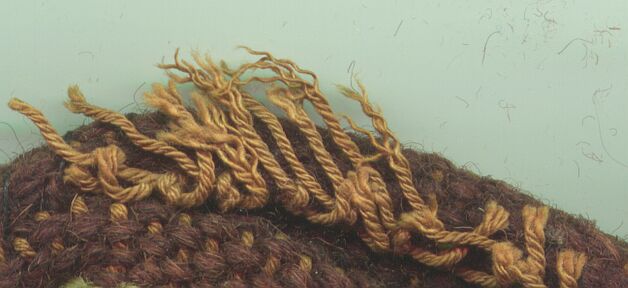
It seems to me that they are
probably wool and although they are very regular and seem likely to be machine
spun, I don't see any trace of anything that looks "man-made." I think David
said he saw some "blue-ish" threads but I'm not seeing that.
I don't
know what machine spun warps suggest about age but clearly younger rather than
older. I remember Eiland saying that machine-spun cotton warps began to appear
in goodly numbers in Chinese rugs after 1850 and machine spinning technology
was likely available in Western developed countries before that. But it's also
what a contemporary piece would most likely have.
Regards,
R.
John Howe
Posted by Vincent Keers on 11-14-2002 06:38 PM:
Woops!
Dear John. Think the guy wanted to say that the wool
wasn't wool. It looks glossy as if some plastic is involved. Akzo, Basf etc. If
it is VERY soft this is probably the case.
Burn it! John. Burn it! This will
help.
Best regards,
Vincent
Posted by R. John Howe on
11-15-2002 04:51 AM:
Vincent -
I've taken your advice and clipped a few strands of
this tan warp into a white china dish and lit them with a match.
Here's
what the results look like:
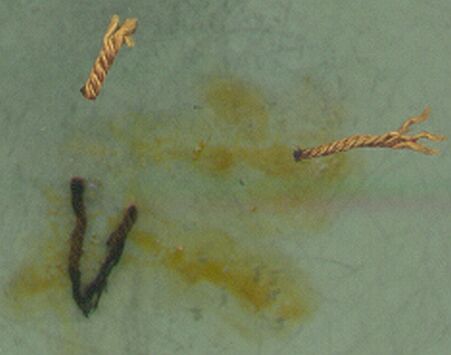
As you can see, the warp burns with a dark ash. It smells
like burned newpaper which suggests that it is cotton. But it also leaves an
orange stain or residue which may suggest that the cotton is coated with
something. Could a dye leave such a residue?
This warp before burning
does not seem particularly "soft" to the
touch.
Thoughts?
Regards,
R. John Howe
Posted
by Vincent Keers on 11-15-2002 08:45 PM:
Dear John,
This image of yours is real Art.
I've copied it and
it's on my monitor now for a while. Next time, shoot as it burns.
Mercerized cotton?
What about the split-work I mentioned in my
previous posting? Not right?
You should see some thread ending at the
corners, or the weaver pulled the thread through at the next level.
Best
regards,
Vincent
Posted by Daniel_Deschuyteneer on 11-15-2002
09:29 PM:
Ridges
Hi John,
Your picture of the back side is very clear and I am
thinking without handling the rug that you are feeling unusual ridges at the
back side because the wefts don't interlace all the warps as in Marla's
drawings but jump at the back side over three
warps
Best,
Daniel
Posted by R. John Howe on
11-16-2002 08:08 AM:
Daniel -
The possibility that you mention of the wefts traveling
over more than one warp at the devetailed joint is plausible. If so, it appears
to me in the photos not to move over more than two warps. And its not clear to
me why the ridge and the "wide" stitch is on the left side of the color change
and seems separate from the ones that actually dovetail together.
(Marla
must be at least smiling at my attempts to describe this
structure.)
Vincent -
I'm not sure I'm taking in your "split
weave" suggestion fully. Are you thinking that perhaps this structure is
basically split weave tapestery on which the weaver has closed up the slits
afterward? I have not heard of such a weave and there is no sign that the
threads in the thick areas are anything except the basic wefts being used in
the piece.
The warp may well be cotton but it is not, I think,
mercerized cotton of the sort that sometimes poses as silk. It is not soft and
silky to the touch.
Thanks for both of these
suggestions.
Regards,
R. John Howe
Posted by Brenda
Zimmerman on 11-16-2002 04:46 PM:
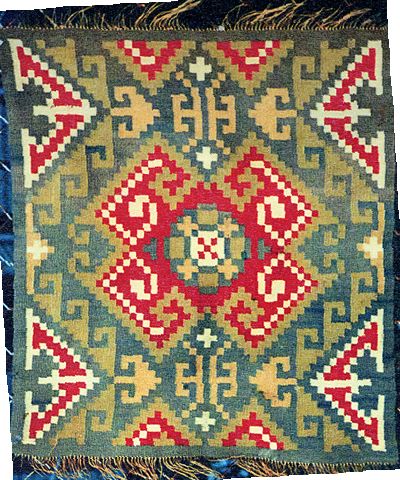
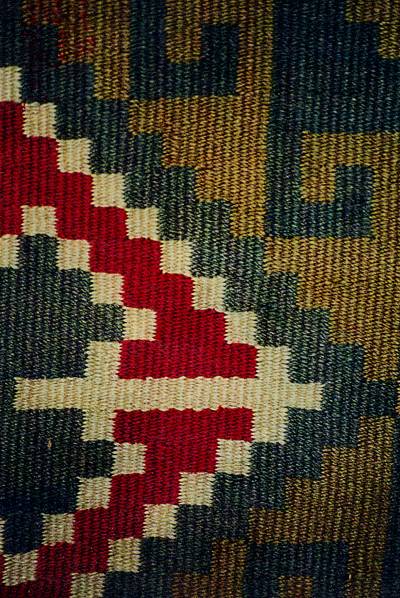
This piece came to the southern part of the USA through
Minnesota or Wisconsin. I am interested in the age, significance of the design
and colors, actual place of origin if it may be known, are there others that I
could look at, is there any literature available, etc...
Thanks,
Brenda Zimmerman
brendaz@cbi1.net
Posted by R.
John Howe on 11-16-2002 07:48 PM:
Ms. Zimmerman -
Welcome to our conversation.
I can see why
you might feel that this piece might be considered usefully in this thread. It
is possible that it is one of these Scandinavian wedding textiles
too.
If it is, it comes from, or is made in the style of the work of
weavers in two very southern districts in Sweden, called together with the name
"Scania."
From what I can see in the two images you provide, it does
appear that your piece is made using a "dovetailed" species of tapestry. It
seems somewhat different from the piece with which I started this thread in
that there seem no areas of noticeable "thickness" to the left of the vertical
color changes. But I don't know if the second image is of the front or of the
back. (Ridges would show on the back.)
You say this piece likely came
through states with goodly numbers of Scandinavian folks and that may be
significant.
Again, only, if this piece is one of the group we have been
discussing here, the literature most accessible is the Michael Franses article
in "Hali" cited above. Franses says there is some other literature on such
pieces but that most of it is not in English.
If you can describe the
materials in your piece in more detail, some members of the Turkotek community
might be able to give you some further useful comment.
Most of us
collect oriental rugs and textiles and the "groping" you see in our
conversation in this thread (although Wendel Swan's initial response was very
knowing) is in part the result of that.
So we may not have much to share
about your piece.
Regards,
R. John Howe
Posted by
Marla Mallett on 11-16-2002 11:34 PM:
Dear John,
OK, so I smiled at reading your descriptions. No
matter. I’ve sometimes looked at kilims, and then later wished I’d
examined them more closely to see what the structure was for sure.
What
your weaving is definitely NOT, is double-interlocked tapestry. Once
you’ve seen that construction, you’ll never confuse it with another.
That interlocking occurs on the surface of the back side, and is very
prominent. From the FRONT side, double interlocked pieces can be confused with
other tapestry structures.
Single interlocked and dovetailed tapestry
require either very close examination and probing with a needle, to determine
if the yarns actually interlock with each other, or if instead they share a
common warp. Only with a really practiced eye can one tell at a glance. With
single dovetailing, the fabric will be a thicker along the join, as twice as
much yarn is being squeezed into a small area. Interlocking doesn’t
produce as much extra bulk, but the design outlines are usually more ragged and
uneven. Among Middle Eastern pieces, interlocked tapestry is fairly rare.
Theoretically, the crucial, visible difference is this: When you are
looking at the ribbed surface of the fabric, if joins occur BETWEEN the ribs,
the wefts are interlocked. If colors zig-zag ACROSS a single rib, it’s
dovetailing.
With your piece, John, this is confused, because the maker
used what most weavers would consider improper sequences, meaning that to make
the dovetailed joins there was an extra warp to cross on one side of each join.
It’s very difficult to see with Brenda’s piece, and a closer view
would be helpful—of both front and back. It is so regular that in any
case, this was a very practiced weaver.
As for the warps in your piece,
John, is the material possibly linen or hemp? Those are popular warp materials
among Scandinavian weavers.
Hope I haven’t confused things
further.
Best,
Marla
Posted by R. John Howe on
11-17-2002 06:51 AM:
Marla -
Thanks for this response.
Your suggestion that the
warps on my piece could be linen is plausible. They do have a linen-like look
and feel.
If "hemp" is the same as "jute" I think that less likely. I
worked with (larger) strands of jute frequently in my macrame knotting days and
that fiber is much rougher in finish. It actually "burns" one's hands if you
tie knots with it for a few hours. There is a "waxed jute" but that has an
entirely different appearance and handle, almost like very thin licorice
sticks. (I have used the latter sometimes to restore the plaited "hair" on
wooden antique African masks.)
Regards,
R. John Howe
Posted by Marla Mallett on 11-17-2002 12:46 PM:
John,
Hemp is quite a bit softer than jute. It’s often used
as a cheap substitute for linen, and sometimes is confused with unbleached
linen. It's a shorter and less durable fiber however. Soft brown burlap bags
are usually hemp.
Best,
Marla
Posted by R. John Howe on
11-17-2002 01:41 PM:
Marla -
Yes, I should have consulted some source before I wrote.
I see that hemp "Cannabis sativa," and is distinct from jute "Corchorus
capsularis" or "Corchorus olitorius."
I can't say that I've seen hemp of
the sort you describe (I've seen large naval ropes of hemp), but if it is used
as a substitute for linen, then it does seem a possible alternative for the
warps of my piece.
Regards,
R. John Howe
Posted by R.
John Howe on 11-21-2002 10:14 AM:
Dear folks -
While searching for something else early this
morning I ran into a book by Jack Franses, "European and Oriental Rugs," 1970,
in which he gives brief descriptions of rugs from many parts of the rug and
textile producing world.
In it he has entries for Norway, Sweden and
Finland. He indicates that various kinds of "tapestry" weaves have been
employed in these countries for centuries.
Surprising to me, he says
that "rya" rugs, (they originated in Finland) which are very shaggy nowadays
with lots of wefts in between rows of long pile knots, were originally made in
a flatweave. Not the sort that we have been talking about in this thread but
something more like sumack, since the weave had lots of threads hanging loose
off the back.
He also confirms Marla's indication that the warps on
Scandinavian tapestries tended to be wool until the latter part of the 19th
century when cotton and hemp began to be used.
Here is one black and
white image of an old Norwegian "rya" tapestry whose design and format seem
somewhat similar to the one with which I began this thread.
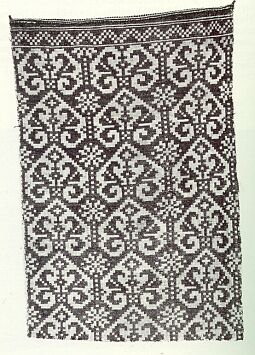
He gives the date of this piece as 1635. He says that the
earliest evidence of a rya rug occurs in an inventory in Finland in
1495.
Franses also says that "rya" rugs were not just dowry pieces (he
calls them "the maiden's bottom drawer") but were the wife's absolute property.
They belonged to her at her husband's death regardless of what the "will" said.
These weavings were part of the goods she inherited automatically and were
called the "Widow's Bed."
Interesting things in the middle of the
night.
Regards,
R. John Howe

















